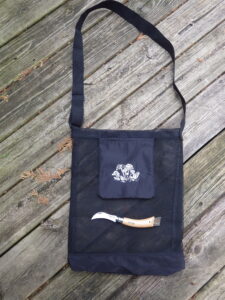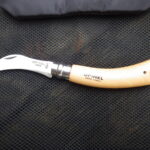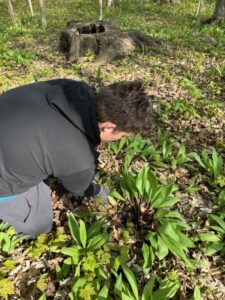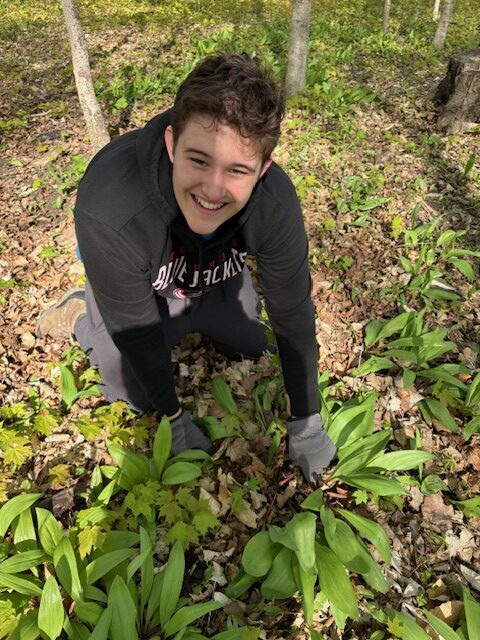Humans from the beginning of time have been foragers seeking edible plants in order to survive, and foraging in the wild remains to be a highly popular
outdoor pastime today. When spring finally makes its appearance after a lengthy winter, foraging becomes a primary focus for a whole lot of folks, me included.
There are great books available today to enlighten potential foragers on how to go about searching for edible plants, and most important, how to properly
identify them.
May is well known for being “morel month”, especially in Michigan. Springtime weather and temperatures play a key role as to when morels will make their appearance. Weather also determines as to the quantity of morels which will be out. My method is to keep looking and hope for the best, and I’ve
found that morels tend to naturally blend in with the surroundings and can
suddenly appear overnight. They can even be in plain sight and still hard to see!
There definitely is a skill level to acquire to become frequently successful,
including knowing what type of ground/habitat to begin an old-fashioned
“shroom hunt”. Morels and certain tree species share a symbiotic relationship,
which is a clue as to where to begin looking.
The black morel and the yellow morel are the ones which I encounter most
often, but there are other species and nope, folks, I’m not a mushroom expert by
any means. There is also the white (common) morel which I may confuse at times
as being a yellow morel, but that is no matter to me. “True” morels are easy for
me to identify as being edible, and no matter the species, I love to eat them all!
A true morel will have the notable sponge-like top adjoined to the stem,
while “false” morels have a separate cap which is quite evident, and a true morel
when split in half will be hollow, whereas the false morel usually isn’t. False
morels, although not considered as being edible, have been consumed by some
humans with no ill effects, but it is possibly something which can eventually have
an impact on the constant consumer. A prime example is the beefsteak morel
which happens to be very popular with many folks, and saying whether it is safe
to eat or not, is definitely quite controversial. The fact is, the beefsteak morel is officially classified as being a false morel, has a solid core, and not considered by most experts as being edible. It contains a chemical when ingested, which is the same component used in rocket fuel. I had one beefsteak morel fan tell me that proper cooking will always burn off the possibly harmful chemicals. Some folks have been able to consume it without ill
effects for their entire lives, while others were not so lucky. Exposure over time, I
guess, can sometimes catch up to certain folks.

Forager’s “tool kit”
A case in point is an avid mushroom hunter I knew who had consumed beefsteak morels for years, and he dearly looked forward to their appearance each spring. Then came the moment during a dinner while consuming (cooked) beefsteak morels, when he suddenly became deathly ill, and had to be rushed to the hospital, where he was put on life-support and nearly died. His skin still had a yellow pallor (clearly identifying a definite liver issue) for months after his lengthy recovery. His wife and daughter had eaten the same mushrooms without any ill effects whatsoever.

When it comes to morel picking, I always use a knife to cut the stem just above the ground. Trying to simply pluck or pinch it off with your fingers can damage the root system, and causing an adverse effect for future morels. I also once read that a few morels should be left in a favorite patch to allow eventual
spores released by them to assist reproducing matters.
However, I must admit I’m a tad guilty for not wanting to leave any hard to find morels behind, and I’m sure I naturally miss enough, that will do the job.
Another springtime delight I enjoy foraging for is the wild leek, which is also
called a “ramp”. Ramps are wild onions which have a mild garlic flavor, and the
entire plant, including its leaves, is edible, raw or cooked. Care must be taken in
harvesting ramps because you are digging the entire plant up, and it can be easy
to completely deplete and eventually destroy a patch. Because you are harvesting
the entire plant, while legal on private lands, it is illegal to forage for ramps on
public lands in Michigan. I do have my favorite ramp hotspots where I have
permission to forage for on private property, and like foragers everywhere, I’m
quite secretive about those locations. The fact is, avid foragers are among the
most secretive folks I have ever encountered!

Ramps, which grow in clumps, are quite easy to identify, and feature green, blade-shaped leaves and reddish stems. To double-check matters, crush a leaf
with your fingers, and there will be a distinct onion/garlic odor, and the root is a bulb-like affair. The roots can be small, usually much smaller than garden leeks, but they are quite flavorful! I like to use the raw leaves and diced roots in salads, as well as the ramp roots fried in butter with fresh morels is one of my favorite springtime recipes. Ramps are also great when grilled whole, leaves and roots. I use a garden spade to carefully dig up ramps, avoid annihilating a clump, and put the soil back in place. I don’t believe it is wise to
leave matters to appear as if a hog was “rooting” around.
Wild asparagus is another plant I regularly forage for in the spring. It is
actually a non-native plant species, having been brought in by European settlers
to this country way back when. Asparagus prefers a good dose of sunlight and
here in my Thumb area, is commonly found along roadsides, ditches and
fencerows. I have some special spots in fencerows and on the ditch on my farm,
and when properly picked on a regular basis, asparagus comes right back, year
after year. And nothing beats foraging for it in the wild form!
As summer eases in, my foraging efforts lean towards foraging for various
wild berries (which is legal on public land, where some of my favorite spots are
located). Elderberries, blueberries, blackberries and raspberries are definitely on
the list. And those small wild strawberries, when I find them, are the most
flavorful and sweetest ever.
Yep, folks, a day spent doing some wild foraging is a great, and even at
times, quite a challenging way to enjoy the great outdoors, which I truly look
forward to each year.
- Fickle weather during December deer hunting adventures - December 3, 2025
- Michigan’s most popular opening day – November 15th - November 23, 2025
- A missing dog found while anticipating opening day - November 23, 2025

